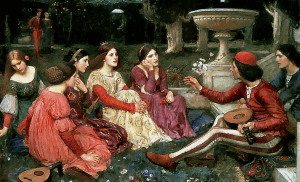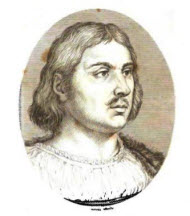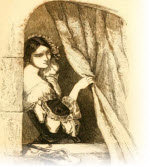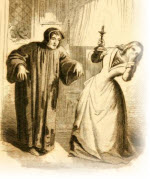
Decameron

Here you will find information about the Decameron.
The Decameron (de-kam'e-ron). [It. Il Decamerone; from the Greek words for "ten", and "day"] is a famous collection of 100 tales, by Boccaccio, published in 1353. Of these tales ten are represented as told each day for ten days, near Florence, during the plague of 1348.
The stories of the Decameron were written from 1344 to 1350, and are preceded by a masterly description of the plague at Florence. They range from the pathetic to the grossly licentious. The book was an immediate success, and influenced many contemporary and later writers. The framing device of a group of people telling stories has been adopted by many other writers, and the stories themselves have been adapted and in some cases plagiarized by many other authors. The Decameron was soon translated into other languages, including English, and though these translations provided source material for Shakespeare and other playwrights.
The seven imaginary ladies and three gentlemen whom Boccaccio supposed to shut out the horrors of the great plague of Florence, in 1348, by enjoying themselves in a garden with a ten-day feast of story-telling, presented— in the best and easiest, though nearly the first, Italian prose—among their hundred tales the choice tales of the day from the French fabliaux, from incidents of actual life, or from whatever source was open to the author. Even the machinery in which the tales are set came from the East, and had existed in a Latin form two centuries before. The number of the stories also was perhaps determined by the previous existence of the “Cento Novelle Antiche. (100 Ancient Stories)” Morley, English Writers, I. 22.
The Decameron is a collection of one hundred stories told by a group of men and women, who have taken refuge from the plague at a villa outside Florence. It was originally written in Italian by Giovanni Boccaccio, and was soon translated into many languages of Europe.
The structure and style of the Decameron influenced many writers and had a profound effect on the development of European literature, which continues to this day. For example, the plot device of using the characters to tell stories as a way of unifying otherwise unconnected tales was adopted by notable writers such as Geoffrey Chaucer in the Canterbury Tales, as well as Marguerite de Navarre in the Heptameron. The plot and themes of many of Boccaccio's tales were also "borrowed" and reworked by Shakespeare in many of his plays. Many other lesser writers and works have also imitated the Decameron, but the Decameron has retained its appeal and remains widely read even today.
The Decameron also had an impact on the development of the Italian nation and language. Boccaccio's use of the Florentine dialect of Italian created a common linguistic standard in the Italian Peninsula, which at

the time was divided into separate and often warring city states, each with its own different dialect and pronunciation. The Decameron was the first work written in vernacular Italian which was popular throughout Italy and served to unite the people in a common culture.
The goal of this site is to make the Decameron accessible to a modern generation. Here we have assembled a collection of various online translations of the Decameron as well as the original Italian edition. You will also find short articles and summaries of each of the stories of the Decameron, descriptions of the characters, a biography of Giovanni Boccaccio, and other essays about Renaissance Italy and the effect of the Decameron on the development of English literature. There is also a library of the other works by Boccaccio.
The key areas dealt with on this site are:- Decameron
- Boccaccio (Giovanni Boccaccio)
- Decameron Boccaccio
Advertisements:



Site Updates | Privacy Policy | Site Map | About
This is a website about the Decameron.